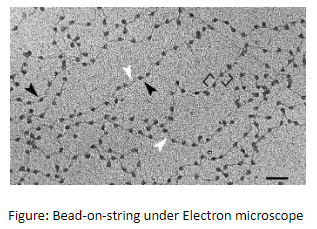Answer
382.5k+ views
Hint: The chromatin fibres are formed when the beads-on-string structure in chromatin is packaged. These chromatin fibres further coil and condensed in cell division (metaphase stage) to form chromosomes.
Complete step-by-step answer:
The packaging of DNA helix in eukaryotes is more complex as compared to prokaryotes. There is a set of a positively charged protein called histones. These charges are depending upon the abundance of amino acids residues with charged side chains. The histones are rich arginines and lysines amino acid residues. These amino acid residues carry a positive charge in their side chain. Histones are arranged to form a unit of eight molecules, called histone octamers. The DNA that is negatively charged is wrapped around a histone octamer (positively charged) and forms a structure called a nucleosome. A classic nucleosome contains 200bp of DNA helix. In the nucleus, the nucleosome constitutes the repeating unit of a structure called chromatin. It is a thread-like stained body present in the nucleus. When viewed under electron microscopes the nucleosome in chromatin appeared as a bead-on-string structure. The bead-on-string is packed in the chromatin and forms the chromatin fibres. Further, these fibres condensed and coiled in the metaphase stage of the cell division to form chromosomes. At a higher level, the packaging of chromatin required an additional set of a protein called non-histone chromosomal protein.

Option D is the correct answer.
Note: In prokaryotes such as E.coli, they do have a defined nucleus. Hence the DNA is not scattered throughout the cell. The region called a nucleoid, the negatively charged DNA is held by some positively charged protein. The DNA in the nucleoid is arranged in a large loop held by protein.
Complete step-by-step answer:
The packaging of DNA helix in eukaryotes is more complex as compared to prokaryotes. There is a set of a positively charged protein called histones. These charges are depending upon the abundance of amino acids residues with charged side chains. The histones are rich arginines and lysines amino acid residues. These amino acid residues carry a positive charge in their side chain. Histones are arranged to form a unit of eight molecules, called histone octamers. The DNA that is negatively charged is wrapped around a histone octamer (positively charged) and forms a structure called a nucleosome. A classic nucleosome contains 200bp of DNA helix. In the nucleus, the nucleosome constitutes the repeating unit of a structure called chromatin. It is a thread-like stained body present in the nucleus. When viewed under electron microscopes the nucleosome in chromatin appeared as a bead-on-string structure. The bead-on-string is packed in the chromatin and forms the chromatin fibres. Further, these fibres condensed and coiled in the metaphase stage of the cell division to form chromosomes. At a higher level, the packaging of chromatin required an additional set of a protein called non-histone chromosomal protein.

Option D is the correct answer.
Note: In prokaryotes such as E.coli, they do have a defined nucleus. Hence the DNA is not scattered throughout the cell. The region called a nucleoid, the negatively charged DNA is held by some positively charged protein. The DNA in the nucleoid is arranged in a large loop held by protein.
Recently Updated Pages
Three beakers labelled as A B and C each containing 25 mL of water were taken A small amount of NaOH anhydrous CuSO4 and NaCl were added to the beakers A B and C respectively It was observed that there was an increase in the temperature of the solutions contained in beakers A and B whereas in case of beaker C the temperature of the solution falls Which one of the following statements isarecorrect i In beakers A and B exothermic process has occurred ii In beakers A and B endothermic process has occurred iii In beaker C exothermic process has occurred iv In beaker C endothermic process has occurred

The branch of science which deals with nature and natural class 10 physics CBSE

The Equation xxx + 2 is Satisfied when x is Equal to Class 10 Maths

Define absolute refractive index of a medium

Which of the following would not be a valid reason class 11 biology CBSE

What are the measures one has to take to prevent contracting class 12 biology CBSE

Trending doubts
Difference Between Plant Cell and Animal Cell

Difference between Prokaryotic cell and Eukaryotic class 11 biology CBSE

Fill the blanks with the suitable prepositions 1 The class 9 english CBSE

Change the following sentences into negative and interrogative class 10 english CBSE

How many millions make a billion class 6 maths CBSE

Fill the blanks with proper collective nouns 1 A of class 10 english CBSE

Give 10 examples for herbs , shrubs , climbers , creepers

What organs are located on the left side of your body class 11 biology CBSE

What is BLO What is the full form of BLO class 8 social science CBSE



